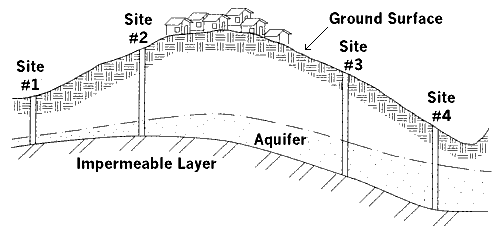
Appendix D
Well Siting ExerciseWhen deciding where to drill, often multiple sites are identified, each having advantages and disadvantages. The Action Agency, the Village Water Committee, the drillers, government representatives and hydrogeological consultants must together decide which site is best for the community.
Figure 24 is a simplified example of 4 alternative sites from which one must be selected. Discuss the pros and cons of each option and make a selection.
Figure 24: Alternative Well Sites

Site #1: This site should allow easy access to groundwater because the water table lies close to the surface of the ground. However, limited water would be available because the layer of impermeable rock also lies near the ground surface. Thus, slight fluctuations in the water table would drastically affect the availability of water.
Site #2: This site is closest to the village and, therefore, has the greatest accessibility. However, the water table is quite deep and may be difficult to reach. The aquifer cannot be penetrated too deeply, because of the position of the impermeable layer.
Site #3: The aquifer can be reached here without digging very far down. The aquifer can also be deeply penetrated, thus ensuring a reliable water source. However, the site is some distance from the village and below the homes.
Site #4: The most water can be reached with the least difficulty. The site is at the greatest distance from the village. It is in a low spot that may be subject to flooding.